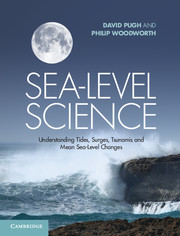Book contents
- Frontmatter
- Contents
- Preface
- List of acronyms
- List of main symbols
- Chapter 1 Introduction
- Chapter 2 Sea-level measuring systems
- Chapter 3 Tidal forces
- Chapter 4 Tidal analysis and prediction
- Chapter 5 Tidal dynamics
- Chapter 6 Shallow-water and coastal tides
- Chapter 7 Storm surges, meteotsunamis and other meteorological effects on sea level
- Chapter 8 Tsunamis
- Chapter 9 Spatial variations in sea level
- Chapter 10 Mean sea-level changes in time
- Chapter 11 Sea-level changes in time to do with the solid Earth
- Chapter 12 Sea-level applications
- Chapter 13 Sea level and life
- Appendix A Basic hydrostatic and hydrodynamic equations
- Appendix B Currents
- Appendix C High and low water times and heights from harmonic constituents
- Appendix D Theoretical tidal dynamics
- Appendix E Legal definitions in the coastal zone
- Glossary
- Index
- References
Chapter 9 - Spatial variations in sea level
Published online by Cambridge University Press: 05 May 2014
- Frontmatter
- Contents
- Preface
- List of acronyms
- List of main symbols
- Chapter 1 Introduction
- Chapter 2 Sea-level measuring systems
- Chapter 3 Tidal forces
- Chapter 4 Tidal analysis and prediction
- Chapter 5 Tidal dynamics
- Chapter 6 Shallow-water and coastal tides
- Chapter 7 Storm surges, meteotsunamis and other meteorological effects on sea level
- Chapter 8 Tsunamis
- Chapter 9 Spatial variations in sea level
- Chapter 10 Mean sea-level changes in time
- Chapter 11 Sea-level changes in time to do with the solid Earth
- Chapter 12 Sea-level applications
- Chapter 13 Sea level and life
- Appendix A Basic hydrostatic and hydrodynamic equations
- Appendix B Currents
- Appendix C High and low water times and heights from harmonic constituents
- Appendix D Theoretical tidal dynamics
- Appendix E Legal definitions in the coastal zone
- Glossary
- Index
- References
Summary
But who would say that a sea surface is inclined?
Strabo, GeographyIntroduction
Geodesy is a branch of science that is concerned with the Earth’s time-dependent geometric shape, gravitational field and rotation. Over 70 per cent of our planet is covered by ocean, and its shape is largely defined by the mean sea surface, so geodesy and sea-level science are intimately connected. A number of classic texts on geodesy are available [1, 2], and also excellent reviews of modern geodetic techniques [3]. In this chapter, we confine ourselves to a description of some of the main developments in geodesy that relate to understanding the spatial variations in the sea surface. In the next chapter we discuss its temporal variations.
The International Terrestrial Reference Frame
A principal goal of geodesy is to assign coordinates to points on the Earth’s surface as a function of time. Such a time series could be, for example, the height of sea level at a particular location (latitude, longitude) in the ocean, or the height of a benchmark on land. It is important to know something of the geodetic framework within which many of the sea- and land-level measurements described later in this chapter are made.
- Type
- Chapter
- Information
- Sea-Level ScienceUnderstanding Tides, Surges, Tsunamis and Mean Sea-Level Changes, pp. 223 - 251Publisher: Cambridge University PressPrint publication year: 2014



